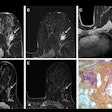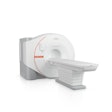CHICAGO - Using magnetoencephalography (MEG), researchers have found that children with autism react to sound an average of 20 msec slower than other children -- a finding that may help to explain the language and communication impairments associated with the disorder.
"The spectral and temporal resolution capabilities of MEG offer a novel approach to understanding neuropsychiatric disorders such as autism spectrum disorders," said Timothy Roberts, Ph.D., vice chairman of research in the radiology department at the Children's Hospital of Philadelphia.
"If there is latency processing a sound, such as 'ah' or 'ou,' you can miss the next syllable," he said, presenting the research at this year's 2008 RSNA annual meeting.
In the study, 30 autistic children ages 6 to 15 years underwent MEG using a 275-channel biomagnetometer while listening to a battery of simple sounds and syllables.
Magnetoencephalography tracks magnetic fields produced by electrical impulses that are created as neurons process each sound, and software measures the time it takes for each sound to reach peak processing, Roberts said.
Results showed that the more severe a child's autism spectrum disorder, the greater the delay in processing sounds. Compared with children without autism, response time was 20% to 50% longer in the autistic children.
"We found that signatures of autism are revealed in the timing of brain activity," Roberts said.
While an average delay of 20 msec in processing a sound such as "ah" may not seem significant, it is the delay for a single sound, Roberts said. With more syllables, there is a cascade of delays that may impair autistic children's ability to comprehend, he said.
When the children listened to two vowel syllables in sequence, such as "ah" followed by "ou," for example, the average delay was 40 msec.
The results suggest that "perhaps slowing speech when communicating with autistic children might be a useful intervention to try," he said.
Magnetoencephalography might help in the diagnosis of autism spectral disorder, particularly during periods of language acquisition, Roberts said. "The next step will be to look at children ages 3 to 5 years, and see if there is any value in toddlers with an ambiguous diagnosis" of autism.
Eventually, the hope "is that these signatures will also be revealed in the infant brain to help diagnose autism and allow earlier intervention," Roberts added.
Currently, there are about 100 MEG centers worldwide, only two of which are in the U.S. -- one at the Children's Hospital of Philadelphia and one at Cincinnati Children's Hospital, Roberts said. A major issue is cost, as the price tag for the machine alone is about $2 million, "and it's about $3 million to $5 million with the facility," he said.
By Charlene Laino
AuntMinnie.com contributing writer
December 2, 2008
Related Reading
Left brain picks desired sounds from cacophony, November 16, 2007
Copyright © 2008 AuntMinnie.com



.fFmgij6Hin.png?auto=compress%2Cformat&fit=crop&h=100&q=70&w=100)




.fFmgij6Hin.png?auto=compress%2Cformat&fit=crop&h=167&q=70&w=250)











